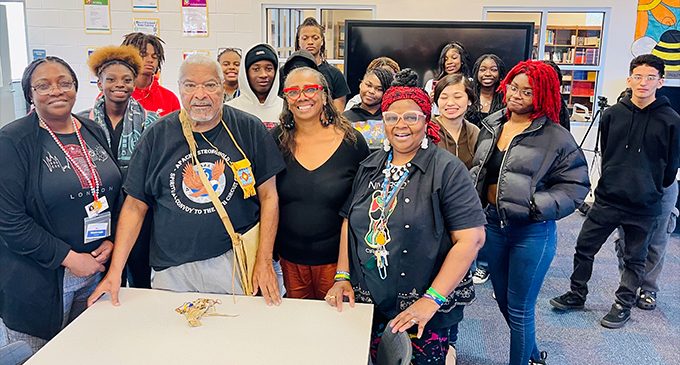Dr. John Mendez shares his experience with Apache spirituality and culture at Carver High School

By Felecia Piggott-Long, Ph.D.
The Rev. Dr. John Mendez retired in 2019 as pastor of Emmanuel Baptist Church in Winston-Salem; however, he is still engaged in the battle and struggle for social justice. Mendez’s connection to civil rights and social justice began when his mother demanded that he join the NAACP when he was in the second grade.
On Thursday, Sept. 28, Mendez addressed more than 70 eleventh grade students at Carver High School who are studying a unit on Native American history and culture.
In 2021 Mendez went to San Carlos Apache Reservation to connect with his friend of 30 years, Wendsler Noise, Sr., spiritual leader of the Apache Reservation. Although Mendez grew up in Harlem, New York, he did not know until he was an adult that his mother grew up on a reservation in Arkansas because she never talked about her roots.
“I grew up not knowing that Native people are very spiritual people. They see God in everything they do. Native people do not build churches, temples, or mosques. The whole earth is their place of worship,” said Mendez. “We even have sacred sites in Pilot Mountain. Before we go there, we have to ask permission from the ancestors as spirits. I stay at the entrance before I visit the sacred sites. The whole earth is sacred, full of minerals, and water, and it is not privately owned. It belongs to the community.
“We fight for the sacred site of Mt. Graham, one of the tallest mountains in America. The Roman Catholic Church and the University of Arizona got together to take over Mt. Graham. They built two telescopes on the sacred site of Mt. Graham,” said Mendez. “We negotiated with the ranger to have sacred services on the mountain. People were dancing. Something ran through my spirit and knocked me down. When I found my composure, I crawled to the old ones.”
Mendez desires to avoid the sacrilege of those who take sacred spaces for granted. As Apache, the Native people carry the sacred stones of white, blue, and black before they touch sacred ground. “The white stone represents the woman, the blue represents the man, and the black represents the sacred and the powerful spirituality that permits me to visit other sacred sites,” said Mendez. “Ubuntu is African recognition that I am because We are.”
On Oct. 22, 2021, the Apache religion was on trial during a week-long hearing in the 9th Circuit Court in San Francisco. Mendez came to join his friend for the hearing for the protection of sacred lands. “The purpose of the spiritual convoy was to protect the sacred sites of Oak Flat, Mt. Graham, and all the Earth, and to recognize the Apache and all native religions as authentic faiths that deserve to be recognized and protected,” Mendez said.
When Emmanuel Baptist Church built their new building, the Apache came to help dedicate the building. “There was representation from the Jewish community, Muslims, Africans, Hispanic, so many cultures represented. This was the first time many people experienced meeting Native people,” Mendez said.
“There has been an attack on Critical Race Theory,” said Mendez. “We are invisible. We don’t count. So many Americans don’t want to know the truth. Colonization, genocide, massacre – these practices cause many to be left out of the story.
“When I visited Germany, I saw the list of names, the Jewish people who were killed. When I came back, I went to the Lynching Museum in Montgomery,” said Mendez. “From 1880-1930, 7,000 African Americans were lynched. Ida B. Wells took on this project to bring honor to those who were lost. Why are there so many Native people left out of our history? How many of you know who you really are? Where your roots are?”
Mrs. Collins was pleased with the success of the presentation Dr Mendez shared with the students.
“It was an informative, awesome presentation. I enjoyed it. He spoke on the Native American creation myth that the students have been learning about,” Collins said.
“The presentation was very successful. The students were very engaged in the lesson he was teaching,” said Mrs. Kimbrough. “When I turned to look at them, their eyes were fixed on him.”








